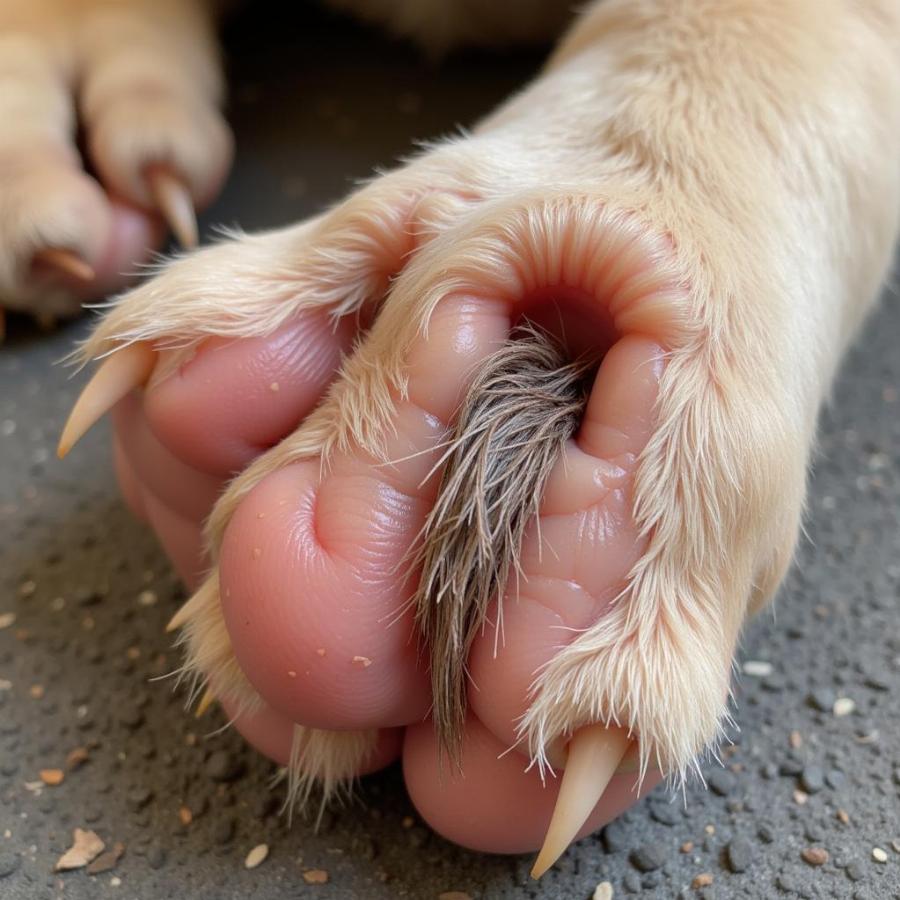Dog hair slivers can be a painful nuisance for both dogs and their owners. These tiny, sharp hairs can embed themselves in skin, paws, eyes, and even internal organs, causing irritation, infection, and discomfort. Understanding how to prevent, identify, and remove dog hair slivers is crucial for maintaining your furry friend’s health and happiness.
What are Dog Hair Slivers and Why are They a Problem?
Dog hair slivers are essentially tiny, sharp pieces of broken dog hair that can penetrate the skin. They’re most common in double-coated breeds that shed a lot, but any dog can produce these troublesome little barbs. The problem arises when these slivers work their way into sensitive areas, causing a range of issues from mild itching to serious infections.
Why are they so problematic? Dog hair, unlike human hair, is often barbed or has microscopic scales, making it easier to embed and harder to remove. These barbs allow the sliver to move further into the skin with each movement, exacerbating the irritation.
Identifying Dog Hair Slivers in Your Dog
Recognizing the signs of a dog hair sliver is the first step towards addressing the problem. Your dog might exhibit excessive licking, chewing, or scratching at a particular area. You might notice redness, swelling, or even discharge around the affected area. Sometimes, you can see the sliver protruding from the skin, but often it’s hidden beneath the surface.
Common Areas Affected by Dog Hair Slivers
- Paws: Slivers between the toes can cause limping or persistent licking.
- Skin: Embedded slivers can lead to localized inflammation and infection.
- Eyes: Slivers in the eyes can cause excessive tearing, squinting, and redness.
- Ears: Slivers in the ear canal can lead to head shaking and ear infections.
- Nose: Slivers in the nose can cause sneezing and discharge.
 Dog Paw with a Hair Sliver
Dog Paw with a Hair Sliver
Removing Dog Hair Slivers: Safe and Effective Methods
If you suspect your dog has a hair sliver, it’s important to remove it carefully to avoid further complications. Here’s how:
- Gather your supplies: Tweezers, magnifying glass, antiseptic wipes, and a soothing ointment.
- Clean the area: Gently clean the area around the sliver with an antiseptic wipe.
- Use tweezers: Using tweezers sterilized with antiseptic wipes, carefully grasp the visible end of the sliver and pull it out in the direction it entered the skin.
- Soothe the area: Apply a soothing ointment to help prevent infection and reduce inflammation.
What to Do if You Can’t See the Sliver
If you can’t see the sliver or it’s too deeply embedded, it’s best to consult a veterinarian. They have the tools and expertise to safely remove the sliver and address any potential infection.
Preventing Dog Hair Slivers: Proactive Steps for a Happy Pup
Taking proactive measures can significantly reduce the risk of your dog getting hair slivers. Regular grooming is key. Brushing your dog frequently helps to remove loose hair and prevents it from becoming embedded.
Grooming Tips for Sliver Prevention
- Choose the right brush: A slicker brush or deshedding tool is effective for removing loose undercoat.
- Bathe regularly: Bathing helps to loosen and remove dead hair.
- Trim long hair: Keeping your dog’s hair trimmed, especially around the paws and sanitary areas, can minimize the risk of slivers.
Conclusion
Dog hair slivers can be a painful and irritating problem for your canine companion. Understanding how to identify, remove, and prevent them is vital for maintaining their health and well-being. Regular grooming, prompt removal of visible slivers, and veterinary consultation for embedded slivers are crucial steps in keeping your dog happy and sliver-free. Remember, a little preventative care can go a long way in ensuring your dog’s comfort.
FAQs
-
Are certain dog breeds more prone to hair slivers? Yes, double-coated breeds that shed heavily are more susceptible.
-
Can dog hair slivers cause serious infections? Yes, if left untreated, they can lead to abscesses or cellulitis.
-
Can I use home remedies to remove dog hair slivers? While some home remedies exist, it’s best to use tweezers and consult a vet if needed.
-
How often should I groom my dog to prevent slivers? At least once a week, but more frequently for heavy shedders.
-
What are the signs my dog has a sliver in its eye? Excessive tearing, squinting, redness, and pawing at the eye.
-
Can dog hair slivers embed in human skin? Yes, they can, and they can cause similar irritation and infection.
-
What should I do if my dog seems uncomfortable even after removing a sliver? Consult a veterinarian to rule out any underlying infection.
Related Articles
- Dog Paw Care Guide
- Common Dog Skin Issues
- Choosing the Right Grooming Tools for Your Dog
Beaut Dogs is your one-stop resource for all things dog-related. We provide expert advice and guidance on every aspect of dog ownership, from breed selection to health care. When you need expert support, feel free to email us at [email protected] for detailed and accurate answers. Beaut Dogs is dedicated to helping you navigate the wonderful world of dog ownership and ensuring your furry friend lives a happy and healthy life. Visit us at https://beautdogs.com!